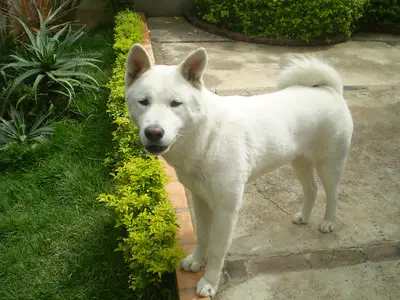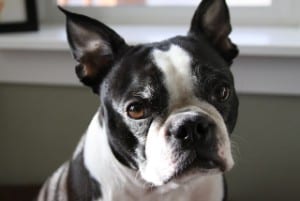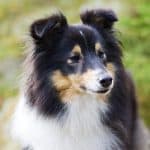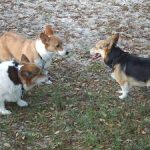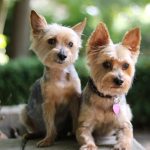Dogs, dogs, dogs. We love them and can’t live without them, they have been our best friends since time immemorial.
In fact, they have been around for so long that it is difficult to keep track of how many species there are specifically.
And one select group of dogs are those who have spots on them, and not just spots anywhere like a Dalmatian has on its hair.
I’m talking about breeds where their spots are on their skin.
And there are more of these than you might realise.
Although it might seem a bit strange to us.
So strange that people might mistake it at first glance as some kind of infection or affilction.
Let’s look at a handful of breeds that are “born” to have have spotted skin:
American Hairless Terrier:
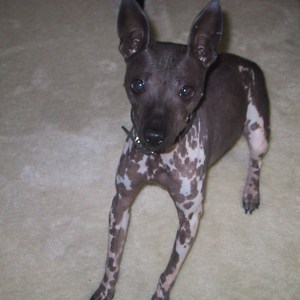
A true southerner to start us off on our look into the realm of hairless dogs. A Louisiana native, the American Hairless Terrier comes in both a hairy and hairless variety. This breed stands at between 12-16 inches at the shoulder and has skin warm to the touch.
The hairlessness of this breed presents its own problems, a lack of a protective coat exposes this Terrier to a host of harsh elements when out and about. Sunburn is a concern for it when exposed to harsh UV rays. And being born and bred southerner, the extreme cold is another problem this breed faces with its lack of a warm protective coat.
But all in all, the American Hairless Terrier makes an excellent companion and is fiercely loyal to their owners. They make excellent watchdogs.
Chinese Crested
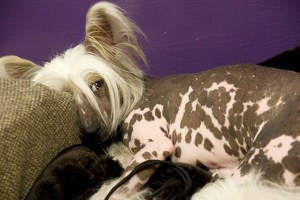
The Chinese Crested is an exotic looking petite dog that funny enough, doesn’t actually hail from China.
This breed makes excellent companions as they are incredibly mellow during lazy afternoons (or lazy whenever as a matter of fact) as they will lie in bed with you for hours, keeping you company during the times when you are feeling like taking some time off of a busy day.
Not known for their energy, you’ll rarely find the Chinese Crested out and about the back porch jumping and running about the backyard as is so commonly done so by many of their counterparts.
They are more than capable of running quickly and jumping over obstacles given their stature, but it just normally isn’t their thing.
Cresteds are excellent family dogs to keep in the home as they love to be with the people in their lives. They do well with children, although you should consider the age of the kids and how they interact with dogs before bringing this small creature into your hearth.
They can be hurt easily and shouldn’t be left unattended with children, or even alone out in the backyard. Remember too that proper socialization is necessary for the Chinese Crested since they can become timid and fearful of people.
The Xoloitzcuintli
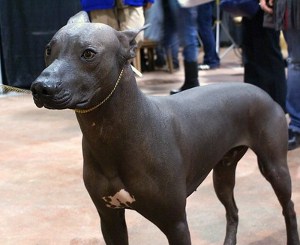
The Xoloitzcuintli (show-low-eats-queen-tlee), is known as the dog of kings, having been kept by the Aztecs for thousands of years.
This breed makes loyal companions and excellent watchdogs.They come in 3 size variations: toy, miniature, and standard, and two varieties: hairless and coated.
The hairless has tough, smooth, close-fitting skin. The coated variety is covered by a short, flat coat. Both varieties come in dark colors, ranging from black, gray black, and slate, to red, liver, or bronze.
The face is thoughtful and intelligent, and a Xolo’s forehead will wrinkle when he’s deep in thought. The Xoloitcuitli’s (or Xolo for short) graceful, elegant body is surprisingly strong and rugged.
These pups are not known for having not only hair, but sharp teeth as well. They eat a mostly meatless diet therefore based on the fact that they were never bred to be hunters.
Having said this, they can eat meat, just don’t expect to make it a staple part of their diet.
In their native Mexico and Central America, they were popular “doctors” — the heat given off by their bodies providing comfort to people with arthritis and other ailments. People still like to cuddle with them today!
African Hairless Dog
The African Hairless Dog, also known as the Abyssinian Sand Terrier are (as the name implies) a mostly Hairless breed of dog.
Some variations will have a patch of hair on the top of their heads while others are completely hairless. The skin tone also varies, some have different shades of gray, often with dull pinkish blotches scattered randomly.
Abyssinian Sand Terriers have bat-like ears, a black nose and an elongated, tapered muzzle, bright round eyes, an arched neck and long slender legs. The body is sleek with a thin, twisted tail, while the chest and the stomach are parallel to its back.
An interesting fact about the Abyssinian is that they are unable to bark unless taught how to do so, such as being kenneled with other breeds of dogs.
However, they are fearless when faced with danger and will display protective tendencies to defend you and your house. Since they are quiet by nature, oftentimes they may have difficulty expressing themselves.
These difficulties may at times lead to mental imbalances and then disobedience. Therefore, it is pertinent to begin obedience training at an early age. And like any dog, the African Hairless Dog loves to run and play so regular exercise is also important for them.
So all in all, early obedience training and regular exercise make this breed an excellent compainion.
Peruvian Inca Orchid
The Peruvian Inca Orchid is an exotic breed from the Andes: a breed that comes in hairless and coated varieties. The breed’s name in Quechua, the language of the Incas, translates to “dog without vestments,” or naked dog.
The hairless Peruvian Inca Orchid (as there are a hairless and hairy variants has smooth, supple skin with a narrow patch of hair on top of the head, sort of like a mohawk. He may sometimes have a little fuzz on the forehead or sparse patches of hair on the lower tail and feet.
This Incan breed has a quiet and reserved manner, making them not the most sociable of dogs. They prefer to take their time studying guests before making a decision on whether or not to accept them.
Therefore, they are unreceptive towards having strangers touch them. As such, early socialization during their puppy years is essential to ensure these dogs are not fearful of new social situations and environments.
On a positive note, these attributes make this South American breed a great watch dog and an excellent companion with older children and adults.
Frequently Asked Questions
Having covered 5 different examples of hairless dog variants, we now know that there are more than just dalmations when it comes to spotted dogs and more than just that, we know that there is a difference between a dog that has spotted fur and one that actually has spots on the skin. That aside, let’s delve in a bit deeper onto some caretaking tips for spotted dogs:
How to Protect The Skin of Hairless Dogs?
Dirt and grim are a huge issue for hairless dogs, so bathing your pet every week or two is a simple way to reduce oil buildup. During the bath, concentrate on removing dirt and oils from the folds that can hide the grim. Keeping folds as clean and dry as possible to prevent infections. During hot weather, sunscreen will come in handy while layers of clothing will also be helpful during hot and cold seasons.
Why Do Some Dogs Have Spotted Skin?
The patches could mean nothing and are no issue of concern, especially if they are present from when the dog is young. This is the most common reason for blotchy spots like this, especially in multicoloured and hybrid dogs. If red or pink patches appear suddenly, especially under the legs or in folds, it could be rashes, which can have many causes. If the dog has a rash, it may lick it continuously as it irritates the dog, and that can cause the skin to darken and thicken around the area, potentially making the affected area worse.
If your dog doesn’t seem bothered by the patches, it is most likely just patches of pigment in the skin. If they appear suddenly or if they itch or cause discomfort to your dog, you should schedule an appointment with a veterinarian.
What Are Hot Spots?
Hot spots are red, inflamed skin. Hot spots are the inflammatory skin lesions worsened by scratching that appear quickly, ooze, and may contain pus, a red flag for infections.
What Are the Main Causes of Hot Spots?
Hot spots are often caused by scratching, licking, or chewing the affected area. The resulting stimulation to the skin causes inflammation as well as bacterial infections. Unfortunately, this self-trauma only makes the area more itchy, which causes a self reinforcing cycle of itching, scratching and further damage.
What Is the Best Way To Treat Hot Spots?
In order to treat hot spots, it will be helpful to clip the hair around the area to prevent matting (for dogs with fur but still helpful to know.) It will be also helpful to clean the affected area with gentle antiseptic solutions such as chlorhexidine. Prescribing topical or oral antibiotics to treat secondary bacterial infections is also another option.
What Is Black Skin Disease?
Alopecia X, also known as Black Skin Disease, is a skin disease in dogs that causes canines to lose patches of hair with dark skin growing back, hence the name. Black skin disease is cosmetic, meaning that it does not cause your dog irritation or pain. However, your dog will be much more susceptible to the elements. They will easily sunburn and could also be more vulnerable to frostbite.
What Are the Main Causes of Black Skin Disease?
Black Skin Disease has been linked to hormonal imbalances, allergies, obesity and genetic factors. Most dogs will begin showing symptoms after puberty occurs and most cases reported are males. Dogs that are diagnosed with black skin disease should not be bred.
What Is the Best Way To Treat Black Skin Disease?
Spaying or neutering your dog should be the first step in their treatment. The reason being that since black skin disease is believed to be genetic, you do not want to breed your dog and possibly produce puppies that will develop the condition. Sterilization may also aid in re-growing the coat because the hormonal changes that will take place after the procedure. The coat re-growth is not always permanent.
Uniqueness Brings A New Joy
Most of us are well accustomed to having a furry friend when we think of dogs. Having a dog lie on its belly and scruff it’s fur while he/she is wagging its tail or scratching them behind the ear is a memorable experience most dog owners would be happy to share with you about.
But there are some dogs that just aren’t the furry type that are equally fun to have around. No they don’t fit into the stereotypical golden retriever or german shepherd with a big mane, but they also don’t shed fur like crazy leaving you a huge mess to clean up after.
A furry and non furry dog are like apples and oranges, no one can say one is better than the other, both types can make great companions, their ancestors have been binded to our ancestors for thousands if not tens of thousands of years, creating a special bond between human and dog.
And not just the furry variant most are accustomed to, the hairless ones as well, both deserve the love of their owners.

